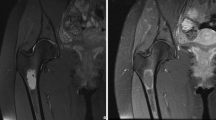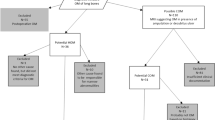Abstract
To determine the relationship and the degree of agreement between radiographs and MR images for the existence of osteoid matrix and periosteal reactions in the initial diagnosis of osteosarcomas. the plain radiographs and MR studies of 54 patients with proven osteosarcoma were retrospectively evaluated. In each tumor the visualization and type of osseous matrix, periosteal reaction and Codman angle were recorded independently for both techniques and by consensus between two radiologists. In 37 tumors agreement existed regarding osteoid matrix and in 31 cases regarding periosteal reactions. The Kappa statistic showed a significant relationship between both tests (0.49 and 0.44, respectively). Both techniques were also not statistically different in the proportion of findings with the McNemar test. Therefore, the ability of MR images seems important in reporting the MR features of bone tumors. Identification of osteoid mineralization and periosteal reaction can also be used with MR in the diagnosis of osteosarcoma.
Similar content being viewed by others
References
Spina V, Montanari N, Romagnoli R. Malignant tumors of the osteogenic matrix. Eur J Radiol 1998;27:S98–109.
Van Trommel MF, Kroon HM, Bloem JL, Hogendoorn PC, Taminiau AH. MR imaging based strategies in limb salvage surgery for osteosarcoma of the distal femur. Skeletal Radiol 1997;26:636–41.
Onikul E, Fletcher BD, Parham DM, Chen G. Accuracy of MR imaging for estimating intraosseous extent of osteosarcoma. Am J Roentgenol 1996;167:1211–5.
Goldin J, Sayre JW. Guide to clinical epidemiology for radiologists: part II statistical analysis. Clin Radiol 1996;51:317–24.
Dwyer AJ. Matchmaking and McNemar in the comparison of diagnostic modalities. Radiology 1991;178:328–30.
Murphey MD, Robbin MR, McRae GA, et al. The many faces of osteosarcoma. Radiographics 1997;17:1205–31.
Murphy WA. Imaging bone tumors in the 1990s. Cancer 1991;67:1169–76.
Fechner RE, Mills SE. Tumors of the bones and joints. Atlas of tumor pathology. Third series, fascicle 8. Armed Forces Institute of Pathology, Washington DC, 1993.
Gronemeyer SA, Kauffman WM, Rocha MS, Steen RG, Fletcher BD. Fat-saturated contrast-enhancedT 1-weighted MRI in evaluation of osteosarcoma and Ewing sarcoma. J Magn Reson Imaging 1997;7:585–9.
Author information
Authors and Affiliations
Corresponding author
Rights and permissions
About this article
Cite this article
Dosdá, R., Martí-Bonmatí, L., Menor, F. et al. Comparison of plain radiographs and magnetic resonance images in the evaluation of periosteal reaction and osteoid matrix in osteosarcomas. MAGMA 9, 72–80 (1999). https://doi.org/10.1007/BF02634595
Received:
Revised:
Accepted:
Issue Date:
DOI: https://doi.org/10.1007/BF02634595




